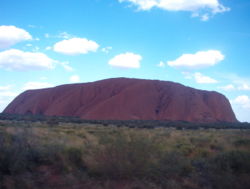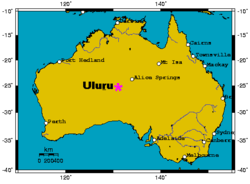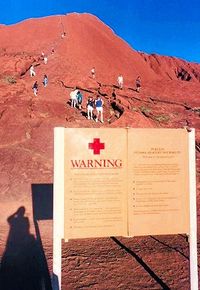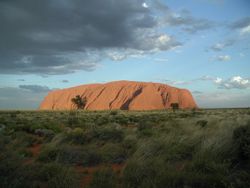Uluru
2007 Schools Wikipedia Selection. Related subjects: Geography of Oceania (Australasia); Geology and geophysics
Uluṟu, also known as Ayers Rock, is a large sandstone rock formation in central Australia, in the Northern Territory. It is located in Uluṟu-Kata Tjuṯa National Park, 440 km southwest of Alice Springs (coordinates ). Uluṟu is sacred to the Pitjantjatjara and Yankunytjatjara, the Aboriginal people of the area. It has many springs, waterholes, rock caves and ancient paintings. Uluṟu is listed as a World Heritage Site for its natural and man-made attributes. It is one of the most well known tourist sites in Australia.
Name
The local Pitjantjatjara people call the landmark Uluṟu ( IPA: /uluɻu/). This word has no other meaning in Pitjantjatjara, but it is a local family name. The underlined ṟ in Uluṟu is a retroflex approximant, as used by some American English speakers.
In October 1872 the explorer Ernest Giles was the first non-indigenous person to sight the rock formation. He saw it from a considerable distance, and was prevented by Lake Amadeus from approaching closer. He described it as “the remarkable pebble”. On 19 July 1873, the surveyor William Gosse visited the rock and named it Ayers Rock in honour of the then Chief Secretary of South Australia, Sir Henry Ayers. The Aboriginal name was first recorded by the Wills expedition in 1903. Since then, both names have been used, although Ayers Rock was the most common name used by outsiders until recently.
In 1993, a dual naming policy was adopted that allowed official names that consist of both the traditional Aboriginal name and the English name. On 15 December 1993, Uluṟu was renamed “Ayers Rock/Uluru” and became the first officially dual named feature in the Northern Territory. The order of the dual names was officially reversed to “Uluru/Ayers Rock” on 6 November 2002 following a request from the Regional Tourism Association in Alice Springs.
Description
Uluṟu is 346 metres high, more than 8 km (five miles) around, and has a harder exterior than many comparable rock formations. This has prevented the formation of scree slopes, resulting in the unusually steep faces near ground level.
Uluṟu is often referred to as a monolith, and for many years it was even listed in record books as the world’s largest monolith. That description is inaccurate, as it is part of a much larger underground rock formation which includes Kata Tjuta (also known as The Olgas).
Uluṟu is notable for appearing to change colour as the different light strikes it at different times of the day and year, with sunset a particularly remarkable sight. The rock is made of arkosic sandstone infused with minerals like feldspar that reflect the red light of sunrise and sunset, making it appear to glow. The rock gets its rust colour from oxidation. Rainfall is uncommon in the area around Uluṟu, but during wet periods, the rock acquires a silvery-grey colour, with streaks of black algae on the areas serving as channels for water flow.
Kata Tjuta, also called Mount Olga or The Olgas, literally meaning “many heads” owing to its peculiar formation, is another rock formation about 25 km from Uluṟu. Special viewing areas with road access and parking have been constructed to give tourists the best views of both sites at dawn and dusk.
History
The beginning of human settlement in the Uluṟu region has not been determined, but gtyjghjghto the east and west indicate a date more than 10 000 years ago. In 1920, the Northern Territory administration gazetted the south-west corner of the territory, including Uluṟu, as the Petermann Aboriginal reserve, thus preventing the expansion of pastoral leases into that area. However, Uluṟu and Kata Tjuta were excised from the reserve in 1958 with the intention of opening them up to tourism.
On 26 October 1985, the Australian government returned ownership of Uluṟu to the local Pitjantjatjara Aborigines, with one of the conditions being that the Anangu would lease it back to the National Parks and Wildlife for ghghjthat it would be jointly managed. The Aboriginal community of Mutitjulu (pop. approx. 300) is near the western end of Uluṟu. From Uluṟu it is 17 km by road to the tourist town of Yulara (pop. 3 000), which is situated just outside of the National Park.
Local legend
Aborigine legends tell of serpent beings who waged many wars around Uluṟu. The wars scarred the rock creating the vertical gutters seen today.
Restrictions for tourists
Climbing Uluṟu
The local Anangu do not climb Uluṟu because of its great spiritual significance. They request that visitors not climb the rock, partly due to the path crossing a sacred traditional dreaming track, and also a sense of responsibility for the safety of visitors to their land. The Anangu have a spiritual connection to Uluṟu, and feel great sadness when a person dies or is injured whilst climbing. In 1983, then Prime Minister of Australia Bob Hawke promised to forbid climbing, but access to climb Uluṟu was made a condition before title was officially given back to the traditional owners.
Climbing Uluṟu is a popular attraction for visitors. A chain handhold added in 1964 and extended in 1976 makes the hour long climb easier, but it is still a long and steep hike to the top. An above average level of fitness, and a high tolerance to the extreme hot desert conditions is required. Over the years there have been at least forty deaths, mainly due to heart failure whilst climbing Uluṟu, as well as non-fatal heart attacks and other injuries. The number of deaths which have occurred after climbing Uluṟu is not known.
Photographing Uluṟu
The Anangu also request that visitors not photograph certain sections of Uluṟu, for reasons related to traditional beliefs (called tjukurpa). These sections are the sites of gender-linked rituals, and are forbidden ground for Anangu of the opposite sex of those participating in the rituals in question. The photographic ban is intended to prevent Anangu from inadvertently violating this taboo by encountering photographs of the forbidden sites in the outside world.
Historical photographs of these formations continue to circulate through the world population at large. Signs have been posted around the restricted areas, to ensure that visitors will not violate the ban by mistake.
Superstitions
It is often reported that those who take rocks from the area will be cursed and suffer misfortune.



